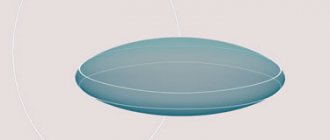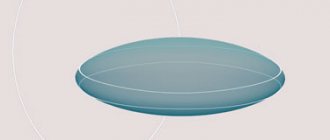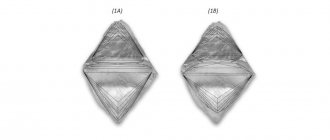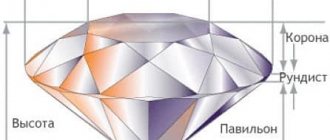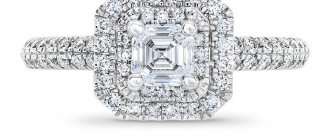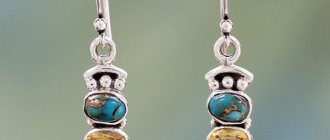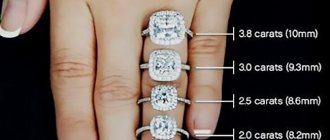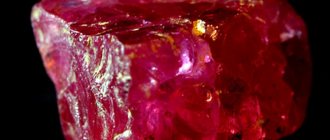Stones are cut to give them a certain shape, to emphasize the shine and play of light. A high-quality cut prevents rays from passing through - they are refracted in the edges of transparent and translucent stones and come back out. First, a scheme is created and thought through, taking into account the shape of the stone, the number, size and location of the edges and angles between the edges. The stones are then cut and polished.
There are about 250 varieties of cuts in jewelry. They depend not only on the taste preferences of jewelers, but also on the physical and optical characteristics of the stones. During the cutting process, it is important to preserve the weight of the stone and its natural advantages. Cutting can be divided into three large groups: smooth , faceted and mixed .
Smooth cut
Although formally it is classified as cutting, in essence it is polishing. The stone processed in this way has no edges, only a polished surface.
Cabochon (from the French caboche - “head” or “nail with a wide and round head”) is the most famous type of smooth cut. The cabochon is considered one of the first, and therefore the oldest, cuts. Honed stone usually has a flat bottom and a smooth, convex dome. Most often it is made in the shape of a circle or oval, although other shapes are also found: rectangle, rhombus, heart, drop, boat, crescent.
Cabochon cutting is used for opaque and translucent stones, as well as for stones with various optical effects (asterism, iridescence, opalescence, cat's eye). This is how jade, turquoise, amber, malachite, lapis lazuli, serpentine, onyx, opal, tugtupite, and sometimes sapphires, rubies and other stones are processed. This cutting method is not very complicated, and the quality of the source material does not play a big role.
Different types of cabochons are used for different tasks and stones. Opaque stones with a colored surface are cut into a single cabochon, which has a flat base and a convex top. For stones with internal defects, the shape of a double (lentil) cabochon, in which both sides are convex, is suitable. Dark stones are often cut into hollow cabochons with a concave base. There is also a tall cabochon with a very convex top and a flat one that looks like a frozen drop of candle wax.
Ball is another smooth cut option. Semi-precious and ornamental stones are processed in this way: aventurine, agate, amethyst, quartz, malachite, onyx, jasper.
Purpose of cutting
Cutting precious and semi-precious stones is a painstaking and time-consuming job. The main task of a jeweler is to obtain a perfect crystal from a nondescript piece of rock. To create a flawless stone, you must achieve the following goals:
- Use the edges to maximize the play of light.
- Maintain or increase color depth.
- Create the perfect shape.
It is possible to achieve the set goals only when the physical properties of a particular mineral are taken into account - hardness, fragility, purity, optical properties. These points influence the choice of cutting method, number of facets, emphasis on color preservation or the original mass of the nugget.
Faceted cut
The most diverse type of cut is faceted or beveled (from the French facette - “edge”). As the name suggests, this treatment creates many edges on the surface of the stone. Faceted cutting is used when working with transparent stones: it brings out their shine, enhances color and emphasizes light effects.
To understand the features of different facet cutting options, you need to understand the anatomy of a faceted stone.
Scheme 1: structure of a cut stone
The upper and lower parts of the stone are separated by a thin belt - a girdle. Usually the frame is fixed on it. The upper part, located above the girdle, is called the crown. There is a platform on it - a flat top face, the largest face of the stone. The lower part, located under the girdle, is called the pavilion. And the point of convergence of the edges of the pavilion at the very bottom is a culet; it can be in the form of a spike, a small horizontal edge or a line.
The faceted cut is divided into two types: classic or round brilliant , and fancy .
Stone processing techniques
The process of processing a precious mineral goes through several successive stages:
- First of all, the craftsman turns the stone, which determines the volume and strength of the future decoration.
- Then the jeweler begins to polish the sample, eliminating roughness, microcracks, and irregularities from its surface.
- After this, the crystal is polished, due to which it acquires a pronounced glass luster.
- After cutting, the gem is washed in a special solution and dried several times with alcohol.
In the past, jewelers performed all these operations manually, but today most stages of mineral processing are carried out on special machines.
Faceted: round diamond
The round brilliant cut is the most common form of cutting for diamonds and other clear stones with strong light dispersion.
The pioneers of the round shape are considered to be the Americans Henry Morse and Charles Field, who in the 1870s created a steam engine for processing diamonds.
The round cut best demonstrates the brilliance and play of light in the stone and minimizes the risk of external damage. A diamond sparkles brightest if the exact proportions of the pavilion's edges are met - they are the ones who ensure complete internal reflection of light. The main disadvantage of the round cut is the significant loss of weight of the nugget: after processing, up to 60% of the original weight can be lost.
The classic or full brilliant cut consists of 57 facets. There are 33 facets on the crown and 24 facets on the pavilion. First of all, this cut is used for large diamonds weighing over 1 carat. The main role here is played by proportions, symmetry and surface quality. The standard of a classic cut is considered to be the “ideal diamond,” the parameters of which were calculated by mathematician Marcel Tolkowsky in 1919.
The simplified brilliant cut consists of 33 or 17 facets. It is used when processing small and medium-sized stones: 33 facets for stones weighing up to 0.99 carats, 17 facets for “diamond chips” weighing up to 0.29 carats. Diamonds, rhodolites, amethysts, sapphires, rubies, peridots, topazes and many other stones are processed in this way.
Photo 1: classic or full diamond cut, the author of this and other photographs is Dmitry Stolyarevich
Types of round cuts that have more than 57 facets are called diamond modifications. These are, for example, the Belgian Highlight (73 facets), King (86 facets) and Magna (102 facets) developed in New York, or the Royal Cut (154 facets).
Why are stones cut?
In their original state, almost all the advantages of natural gems are hidden from human eyes. In order for the stone to acquire a beautiful, regular shape, become smoother, more transparent, and shiny - experienced jewelers engage in mechanical processing of precious minerals. They form a geometrically correct figure from the stone, which emphasizes its natural color palette and refracts light.
Helpful information
The more facets a piece of jewelry has, the brighter it will sparkle under natural or artificial light sources. The maximum number of facets that a jeweler can make on one stone is more than 200. The minimum is 17.
Cutting gemstones is a rather labor-intensive process that only an experienced specialist can do.
Faceted: fantasy. Step varieties
With this cut, the edges are arranged parallel and above each other, like steps. The wide upper platform is made in the form of a polygon, and the side faces are in the form of trapezoids or isosceles triangles.
The step cut does not cause brilliant shine, but rather emphasizes the color of the stone. Therefore, it is used for transparent stones of “medium color tones”: a high cut enhances the color, a low cut weakens it.
The table or table cut is one of the simplest step cuts. Usually it is a flat stone with a large platform: the crown consists of five sides, the pavilion - of four. A variation can be considered the Mirror cut with a very large platform and a shallow pavilion. The table is used mainly for semi-precious and ornamental stones, which are often used in signet rings.
Baguette is an elongated version of the Table, cut in the shape of a rectangle. Shapes such as Trapezium and Square (Care) are often classified as varieties of Baguette.
The modern version of this cut appeared in the early 20th century. Its name comes from the French. bague – Until the 17th century, this word meant precious stones in general. The Baguette has 14 sides, and there are also 24-sided versions. Technically it is quite simple, but due to the openness of the edges it requires high purity of the stone. This is how small side stones in jewelry are mainly cut: diamonds, rubies, emeralds, topazes.
Other quadrangles - Rhombus, Kite, Epaulet, Barrel - are considered varieties of Baguette. They are distinguished by the inclination of the corners and the curvature of the sides. Pentagon and Hexagon are also distinguished as independent forms.
Emerald (Emerald) or Octagon - a step cut with an octagonal shape of the stone. It consists of 58 or 65 edges and looks like a Baguette, but the corners here are not sharp, but beveled.
Modern Emerald standards were adopted in the 1940s - initially this cut was intended specifically for emeralds, but over time, sapphires, tourmalines, beryls, and other stones began to be cut this way. Here, too, high purity and transparency of the stone is required, otherwise imperfections will be visible to the naked eye. But the light that falls on the surface is reflected in wide and bright flashes. In terms of cost and complexity, this is one of the most affordable cuts.
Asscher is an octagonal cut, which is made in the shape of a square and has characteristics similar to Emerald. It was developed in 1902 by the famous Dutch jeweler Joseph Asscher, but it gained popularity only in the 1920s. The original version has 58 edges, and its modification, the Royal Asscher, has 74 edges.
Photo 2: emerald cut
Photo 3: Asscher cut
Faceted: fantasy. Wedge varieties
Wedge cut shapes are often considered variations of the round brilliant cut. In this case, many edges in the form of wedges are applied to the surface, which well reveal the color of the stone and enliven the play of light in it.
Oval – this cut compares favorably with round by maintaining the weight of the stone. It was created in the 1960s by jeweler Lazar Kaplan. Oval-cut stones usually have 57 facets, although the number may vary. The elongated shape allows you to create the illusion of a larger stone; it looks especially advantageous in rings. The oval cut is used mainly for large transparent stones - aquamarines, amethysts, sapphires, topaz.
Marquis (Marquise) is an oval with pointed ends, similar to a boat. This cut was created in France in the mid-18th century, and according to legend, it was dedicated to the smile of the Marquise de Pompadour. The marquise also has 57 facets and is characterized by a slight loss in the weight of the nugget: if the stone is initially oblong, up to 80% can be preserved. This is how diamonds, amethysts, emeralds, and rubies are cut. The Shuttle cut is considered a variation of the Marquise - it has a narrower upper platform and slightly fewer facets.
Photo 3: oval cut
Photo 5: marquise cut
Pear – this cut visually resembles a drop: one end is rounded, the other is pointed. It is sometimes considered a hybrid of the round brilliant cut and the marquise cut. The smooth platform is also made in the shape of a drop, there are usually 57 wedge faces. Such a stone should have clear symmetry at the point of narrowing, since this is where the play of light is concentrated.
Aquamarines, amethysts, and topazes are cut in the shape of a Pear. The Pandelok cut is a variation of the Pear, but its pavilion is deeper and rounder.
Briolette, Drop, Olive (Olive) - varieties of elongated teardrop shape. Unlike Grusha, they have neither a platform nor a girdle. The surfaces of Briolette and Olive are completely covered with wedges, only the shape of the Olive resembles an ellipse with cut ends. In the Drop, the narrow upper part is formed by long edges extended downwards, and the rounded lower part is formed by small wedges. Stones cut in this way are mainly used as pendants.
In elongated Oval, Marquise, and Pear cuts, if the proportions and symmetry are disturbed, the optical effect of a “bow tie” may appear: a dark spot in the center of the table.
Photo 5: pear cut
The Princess is a rectangular wedge cut and is the second most popular cut for diamonds. It was created in the 1980s by jeweler Bezalel Ambar - he branded the original version with 49 facets under the name Quadrillion. The princess has square outlines and sharp corners, and the deep pavilion, where the play of light is concentrated, ends in a spike. The 58 facets create a brilliance that rivals round diamonds, but retains about 80% of the stone after cutting.
Flanders is a modification of the Princess, which has 61 sides. It was also invented in the 1980s, named after the Belgian region of Flanders. Features cut corners and very complex symmetry, so the cutting process takes three times longer than creating a round diamond.
Photo 6: princess cut
Antique (Antique) or Cushion (Cushion) - this cut has existed for more than a hundred years and at one time was almost as popular as round brilliant diamonds are today. The shape of the Cushion (English cushion - “pillow”) really resembles a pillow. The stone has rounded corners, 72 sides, and can be square or slightly elongated. This is how diamonds, amethysts, sapphires, emeralds, rubies, quartz and its varieties are cut. By the way, the cut received its other name - Antique - in recognition of its historical roots: its predecessor is considered to be the Old Mine Cut of the 18th century.
Trilliant (Trillian, Trillion) is a triangular wedge cut created by the Asscher brothers at the beginning of the 20th century. The corners of the stone can be sharp, beveled or rounded; some options have a pronounced triangular area, some do not. The classic Trilliant has 43 facets, but modern versions can have 50 facets or more. This cut is well suited for light stones: diamond, aquamarine, beryl, white sapphire. Some jewelers use it to lighten dark stones - tanzanite, amethyst, rhodolite. Varieties of the Trilliant can be considered the Shield and Troidia cuts, in which the sides are slightly curved outward.
The heart is one of the most complex and expensive wedge cut shapes. It is often used in exclusive jewelry. In principle, it resembles a Pear, but splits on the rounded side, taking the shape of a heart. The stone is usually equal in length and width, and consists of 59 facets - their number may vary depending on the original size of the stone. This is how rubies, amethysts, topazes, garnets, and sometimes colored diamonds are cut.
Ball or Sphere is a rather rare type of wedge cut, which has 120 facets or more. Despite the fact that a stone processed in this way will not sparkle very brightly, the cutting itself is extremely labor-intensive and requires high skill.
Photo 7: heart cut
Also worth noting is the collection of polygonal “floral” cuts (Fire Rose, Sunflower, Dahlia, Calendula, Zinnia), which were created by the famous jeweler Gabi Tolkowsky, nephew of the creator of the “ideal diamond”. They are designed specifically for rough diamonds over 0.25 carats and are based on unusual angular parameters. Russian experts have developed the Happy decagonal cut, which has 81 facets. Visually, it is very similar to a round diamond, but, like many other fancy options, it has less weight loss from the stone.
Basic forms of cutting jewelry stones
Using cutting, you can hide inclusions in the structure, remove cracks, and correct uneven shades. Among the varieties of the process, the following forms are distinguished:
- Traditional round or rose cut. The number of facets is 57 (diamond subtype), 33 or 17. This is a universal form that can be performed on any mineral, but is more often used in relation to diamonds. This is the oldest and most proven processing method, dating back to the early 1900s. The technique demonstrates the shine and play of the mineral in the stone, and also contributes to its “longevity”. It is this form that prevents the appearance of chips or other external damage to the stone. It does not save raw materials, since up to 50% of the material is lost during processing, but the diamond can be recut. If the stone is small, weighing up to 1 carat, then the cut is made on 33 facets, and if the weight is less than 0.3 carat, then 17 facets are used.
- The oval cut also has 57 facets. Most often used in women's jewelry: earrings, rings, bracelets or pendants. The technique appeared in the sixties of the twentieth century. The elongated shape of the stone makes it possible to see the play of shades. If it is used in a ring, such a product visually lengthens the fingers.
- The Marquis technique makes 55 facets to the mineral. This cut of gemstones is used for rings, earrings or pendants. The shape of the stone is oval with pointed ends. The stone turns out to be fragile and visually resembles a smile. It is able to lengthen fingers if the gem is set in a ring. Stones of this type were worn by aristocrats; the technique was first invented in France in honor of the Marquise de Pompadour.
- The “Briolet” technique, also known as “Drop” or “Pear”. The number of facets in it is 55-56, minerals are set in necklaces, pendants or earrings. The variety combines the Marquis and oval methods. One end is tapered and protected by a rim as the sharp side is fragile. The drops come in a variety of sizes and look beautiful in hanging decorations.
- Princess cut with a number of facets of 49, 65 or 68. A relatively cheap type of processing, since the mineral loses little weight in the process. The stone is rectangular or square in shape. The technique is used for processing stones and setting them into wedding rings. But sharp corners require protection with precious metal due to the fragility of the material.
- Octahedron, or “Emerald”, which can have a different number of facets. Used for all types of men's or women's jewelry. The edges are large and not too fragile. But at the same time, the stone must have an impressive size and a good indicator of purity. It will not be possible to hide defects with such processing. You can demonstrate the saturation of the hue, the play of light will be less, but more noticeable in the brightness of the flashes. The cost of minerals after this treatment is expensive due to the characteristics of the stone.
- Usher technology. Minerals with 25, 49 or 72 facets are common, but any number is possible. This is a subtype of the “Emerald” cut, however, with a large number of floors, that is, tiers of facets. The technique was invented in Belgium in 1902 and named after the jeweler brothers Ascher. The number of facets depends on the size of the stone, but the characteristics of the gem should be almost ideal. The cut is suitable for art deco style jewelry.
- The “Radiant” method with the number of facets is 65 or 70. The stone looks like an octagon or square with cut corners. This is a combination of “Princess” and “Emerald”. The technique also requires purity, transparency and play of light. The octagon will look beautiful if the size of the mineral is large. Because of their size, stones are often chosen by men to emphasize their status, but the technique slightly shortens the fingers if used in a ring. It is good to cut polychrome minerals, as well as ametrines, in this way.
- Heart cut shape with 57-58 facets. Used for earrings, pendants or pendants. This type of stone can be given to your beloved. The main thing is to maintain proportions when cutting so that the heart does not become too fragile and vulnerable.
- “Trilliant” or “Trillion” technique. The number of edges may vary. The origin of the cut is Dutch. It arose relatively recently, in the eighties of the twentieth century. This is a fancy cut that is rarely used in practice.
- “Cushion”, the method is also called antique, or antique. The mineral is cut in this way when it is necessary to preserve raw materials and process the material as economically as possible. The weight of the mineral is practically not lost, but the appearance sometimes suffers. The corners of the mineral are rounded and the edges are wide. It even applies to diamonds.
- “Cabochon” has several subtypes, but the common feature of the stones is a round, convex shape. This is the oldest cut, which is now coming back into fashion. There are no facets in such a mineral. The name comes from the French language, because it was in France that the form became so popular that even diamonds were cut with it. Great for minerals with asterism or cat's eye effects. Ornamental or semi-precious stones are most often cut in this way. It is worth paying attention to the grinding and polishing of the mineral.
- Pentagon or hexagon are fancy cuts, shaped like geometric shapes. Sets and decorations of this type are purchased for more than one season. The processing method is only gaining popularity. Large inserts in the product are processed in this way.
To assess the quality of processing, special scales are used. The cut grade and information are indicated on the piece's certificate. If we talk about the scale of the Gemological Institute of America, then there are the following gradations:
- excellent (excellent cut);
- very Good;
- good;
- fair (average);
- poor (unsatisfactory), but the stones can be recut.
In Russia and the CIS countries, the letter value from “A” to “G” is used. “A” corresponds to first-class processing, and “G” corresponds to poor processing.
The types of stone cuts significantly change the appearance of the products and place color accents. But only jewelers understand all the intricacies of the process. Ordinary buyers appreciate the symmetry and external beauty of the mineral - this is what they should pay attention to when choosing jewelry.
